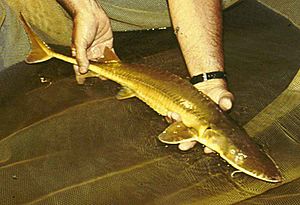Alabama sturgeon facts for kids
Quick facts for kids Alabama sturgeon |
|
|---|---|
 |
|
| Conservation status | |
| Scientific classification | |
| Kingdom: | |
| Phylum: | |
| Class: | |
| Order: |
Acipenseriformes
|
| Family: | |
| Genus: |
Scaphirhynchus
|
| Species: |
S. suttkusi
|
| Binomial name | |
| Scaphirhynchus suttkusi J. D. Williams & Clemmer 1991
|
|
The Alabama sturgeon (scientific name: Scaphirhynchus suttkusi) is a special type of sturgeon fish. It lives in the United States of America. Today, scientists believe it only lives in about 130 miles (210 km) of the lower Alabama River.
This fish has a unique yellowish-orange color. It can grow to be about 30 in (76 cm) long and weigh 2 to 3 lb (0.9–1.4 kg). The Alabama sturgeon is thought to live for 12 to 20 years. Biologists first learned about this fish in the 1950s or 1960s. However, because Alabama has so many different water animals, it wasn't officially named until 1991.
Contents
Saving the Alabama Sturgeon
Why is the Alabama Sturgeon in danger?
The Alabama sturgeon is a critically endangered fish. This means it is at a very high risk of disappearing forever. Scientists and conservation groups are working hard to protect it. They want to make sure this unique fish continues to live in its natural home.
What are scientists doing to help?
In 1993, scientists from the state and federal governments started a program. Their goal was to help save the Alabama sturgeon. They hoped to catch some fish and help them have babies in a safe environment. This is called a captive breeding program.
Unfortunately, finding these fish has been very difficult. Since 1993, only six Alabama sturgeon have been caught. All of these fish were male. The last fish kept in captivity passed away in 2002.
Tracking the last known sturgeon
The most recent Alabama sturgeon was found in April 2007. Scientists checked and saw it was a male. They carefully collected some sperm from it. Then, they put a small tracking device inside the fish. After it healed, they released it back into the river.
Scientists hoped this tagged fish would lead them to other Alabama sturgeon. Sadly, after tracking it for a year, no other fish were found. In July 2009, researchers lost contact with this fish when its tracking device stopped working.
Protecting their river home
In May 2008, the Fish and Wildlife Service suggested protecting parts of the rivers. They proposed making 245 miles (394 km) of the Alabama River and 81 miles (130 km) of the lower Cahaba River a "critical habitat" for the fish. This means these areas are very important for the sturgeon's survival. Even though there are dams on these rivers, how the water flows is expected to stay the same.
A plan for recovery
In August 2013, the Fish and Wildlife Service released a "Recovery Plan" for the Alabama sturgeon. This plan has several important goals. One goal is to create a group of captive fish that can produce young sturgeon, called fingerlings. These fingerlings would then be released back into the wild.
Another part of the plan is to improve the sturgeon's habitat in the Alabama River. This involves making changes to how the Claiborne and Millers Ferry Lock and Dams operate. These changes aim to make the river a better place for the sturgeon to live and reproduce.
Are they still out there?
Even though it's rare to see an Alabama sturgeon, studies in 2014 and 2015 gave scientists hope. They found many traces of recent Alabama sturgeon DNA in water samples from the river. This "environmental DNA" suggests that the species is still alive, even if they are very good at hiding!
Images for kids




